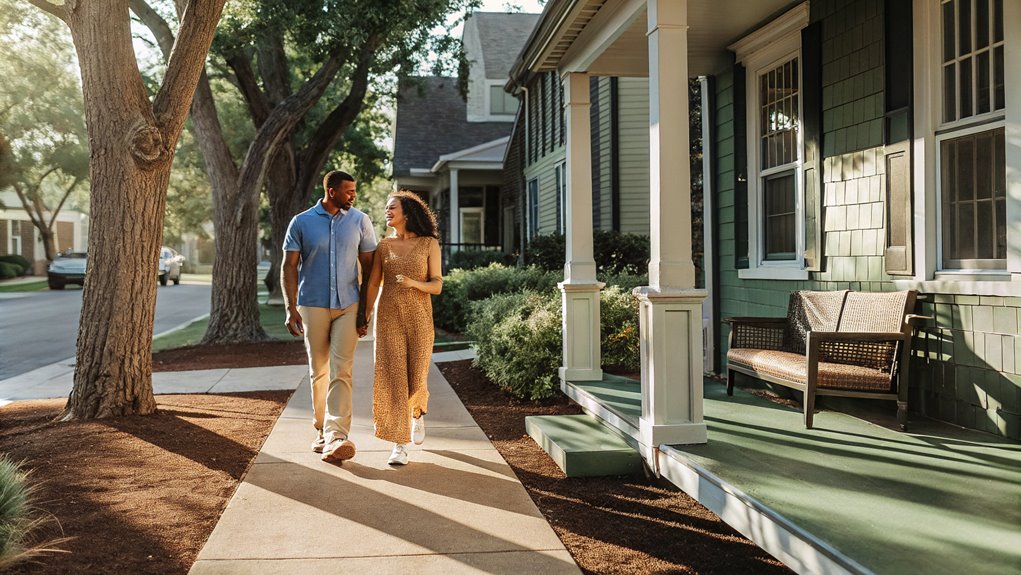Want to really know a neighborhood? Go see it with your own eyes! Walk around in the morning, at lunch, and after dark. Watch how people live there. Look at the cars and see how busy the streets get.
Stop at local places like coffee shops and parks. Talk to the people who live there. Ask them what they like and don't like about their home area. You can learn a lot from a friendly chat!
Look at the houses and yards as you walk. Are they neat and clean? Can you walk to get food or catch a bus? These things matter for daily life.
Try driving the route you would take to work. Visit on weekends to see what people do for fun. This will help you know if you would be happy living there.
Numbers and facts are good, but seeing things for yourself tells you much more about what life is really like in a neighborhood.
Ready to start building equity in your own Michigan home? Get your personalized home loan quote today.
Observe Daily Life Patterns

Life in a neighborhood tells us more than any numbers can. To really know a place, watch what happens there during different parts of the day.
In the morning, from 7 to 9, see how people get to work. Do they walk to the bus? Drive cars? Ride bikes?
At lunch time, look at who's around. You might see people working from home, older folks, or parents with kids.
From 3 to 5, watch what kids do after school. Do they play outside? Do grown-ups stop to talk to each other?
In the evening, between 6 and 8, check out what dinner time is like. Are the restaurants full? Are people walking their dogs? Or are the streets empty?
On weekends, things are different. People might've block parties. Some work in their yards. Friends might chat on their front steps.
Michigan residents, unlock the door to your new home. Request your home loan quote from Treeside Financial today.
Meet The Local Residents
Talk to the people who live in the place you want to know about. Go to coffee shops and parks to find them. Ask them how long they've lived there and why they like it.
Visit at different times of day. You can meet people who walk their dogs in the morning. You can meet people who shop in the afternoon. You can meet others at night. They'll tell you if the area is safe and how good the schools are.
Go to local meetings too. You can see how people work together. Watch if neighbors know each other's names.
You might be closer to buying your home than you think
Take our 2-minute home buyer readiness quiz to see how prepared you really are – no credit check required.

See if they join in fun local events. This shows if people in the area care about each other.
Visit During Different Times

When you look for a new home, visit the area at different times to see how it feels. Go in the morning when people head to work, after dinner when it's dark, and on weekends. This helps you see what life is like there.
Look for simple things each time you visit:
- How many cars are on the street?
- Are people walking around?
- Are stores open?
- Do you see police cars?
Remember that places can change with the seasons. A quiet street in winter might get busy in summer.
Check if the streets have good lights at night. Watch how often trash trucks come by. If there's a school nearby, see how busy it gets when kids go home.
The more you visit, the better you'll know if this place feels right for you.
Check Community Events Calendar
When you want to learn about your community, look at what fun things are happening near you. Check your town's website and local Facebook groups to find events.
You'll see lots of different things to do. There might be markets where people sell fresh food. You might find fun festivals with music and food. Kids can join sports teams, and older people have their own special meetups too.
Look at who plans these events. Sometimes the town runs them. Other times, neighbors work together to create fun for everyone. Local shops help out too.
Some events happen every year, like summer fairs or winter festivals. These special times bring people together and show what matters most to your neighbors.
Walk The Streets

Take a walk around any neighborhood you might want to live in. You can learn a lot by watching what happens there.
Look at how many people walk on the streets. See if homes and yards look clean and neat. Notice if there are security cameras or signs about watching out for crime.
Check if the streets have good lights at night. Watch how many police cars drive by. Pay attention to how friendly people are with each other.
All these little things can tell you if it's a good place to call home.
Observe Daily Street Life
Watch your street to see what makes it special. Go out at different times – morning when people go to work, noon when folks shop, after school, and in the evening.
Look at how people act. Do they say hi? Do they stop to talk? Do they share spaces like parks?
Look at who's on your street. You might see kids with their parents, older people, workers, and all kinds of folks.
See how they use the street, stores, and buses. Look for nice things like pretty gardens and fun block parties. These show if people in your area care and feel safe.
Keep track of what you see. You can make a list or write notes about what happens each day.
Notice Safety Indicators
When you walk around a new area, look for signs that show it's safe. Good signs include bright street lights that work well, clear places to cross the street, and bumps in the road to slow cars down. Many safe homes have alarm systems and lights that turn on when people walk by.
A clean area is often a safe area. Look for clean streets with no trash. Nice parks and clean buildings mean people care about where they live. It's good to see police cars driving around and a police station close by.
Make sure you can see clearly down streets and between buildings. Bushes and trees should be cut short.
Places where many people hang out, like parks and squares, help keep the area safe because more eyes are watching what happens.
Explore Local Gathering Spots
People love to meet at special places in their neighborhood. You can learn a lot by watching these spots. Look for coffee shops, parks, and local stores where friends say hello.
Watch how people use these places. Some folks chat over coffee. Others play with their kids at the park. You might see the same faces each day. Many people know each other's names and stop to talk.
These meeting spots tell us what makes a neighborhood special. They show us how friends come together and what places they love most.
Study The Physical Environment

When you walk around a neighborhood, look at what makes it a good place to live. Check the streets and sidewalks – are they smooth and clean? Do street lights work? Are there parks where kids can play?
Look at the homes too. Nice homes often have pretty gardens and fresh paint. Empty lots or old, broken buildings can mean trouble. See if you can walk to stores or if you need to drive everywhere.
Trees make a street nicer and cooler. Listen for loud noises that might bother you.
Watch how rain water flows when it storms. These little things matter because they show if people care about where they live.
Test Your Daily Commute
Getting to work and back can be a big deal when you pick a new home. Try the drive at the real times you'll be on the road. Go in the morning rush and drive back in the evening rush. Don't just trust what your phone says about drive times.
Look at all the ways to get to the places you go most. Find the best way to work, to school, and to the store. Watch out for roads that get backed up. Think about what happens when it snows or when school buses are out.
Add up how many hours you'll spend in the car each week and how much gas you'll use.
If you can take a bus or train, walk to the stops to see how long it takes. Look for bike paths and sidewalks too if you want to ride or walk.
Experience Weekend Activities

Get to know your new neighborhood by having fun there on weekends.
Go to local events like street fairs and markets. See how many people show up and if it's easy to park your car.
Check out what the place feels like when lots of people are around.
Also visit the parks, movie theaters, and places to eat when most people go there.
This will show you what fun things you can do every weekend.
Visit Local Events First
Going to local events helps you get to know a place better than any numbers can tell you. When you visit farmers' markets, street fairs, and town parties, you see how people really live. You can watch how neighbors talk to each other and what they care about.
Look up events on town websites and Facebook groups. Try to go to three kinds of events. Go to one in the day, one at night, and one on a weekend morning. This helps you see who lives there and if the area feels safe.
Watch how the events run and who comes to them. Look at who sells things and how people talk to each other. These things show you if people in the area get along and work together.
Observe Entertainment Options Live
When you want to learn about a neighborhood, visit its fun spots when they're busy. Go to places like restaurants and cafes on Friday and Saturday nights between 7 PM and 11 PM.
Look at who goes there. Are they young or old? Families or singles? Listen to how loud it gets. See if it's hard to park your car. Check if you can walk to many places or if you need to drive.
Watch how people act with each other. Do they smile and say hi like old friends?
Think about what you like to do for fun. Does the area have places that match what you enjoy? Maybe you like music shows, game nights, or watching sports with others.
This way, you can tell if you'll feel at home in the neighborhood and have fun things to do nearby.
Assess Neighborhood Maintenance Standards
Look around to see how people take care of their homes and streets. This tells you if it's a good place to live. Take walks at different times to get the best look.
Things to Look For:
- Are yards neat and homes fixed up?
- Are parks and paths clean?
- Do the roads have holes?
- Is trash picked up on time?
- Do city workers fix problems fast?
Take a walk and write down what you see. Watch for people fixing things or making the area better. See if most homes look nice, or if some look better than others. Check if stores and homes get the same care. This shows if everyone cares about keeping the area nice.
| Check This | Look At |
|---|---|
| Homes | Grass, paint, fixes |
| Parks | Clean spaces, fixed paths |
| Streets | Good roads, working lights |
| Trash | Clean bins, pickup times |
| City Help | Quick fixes |








